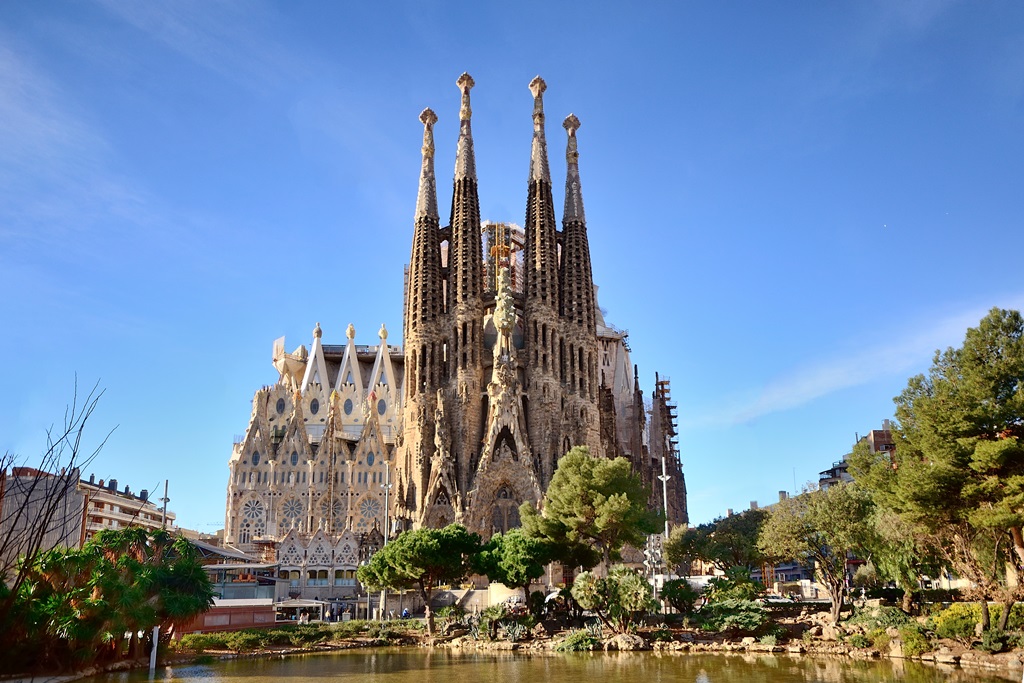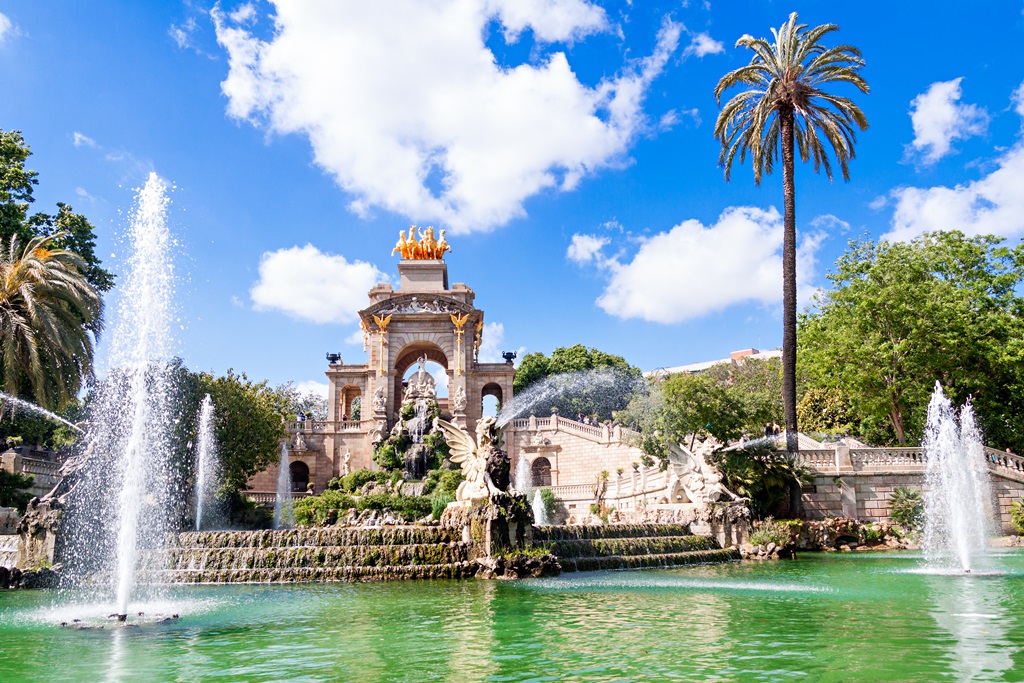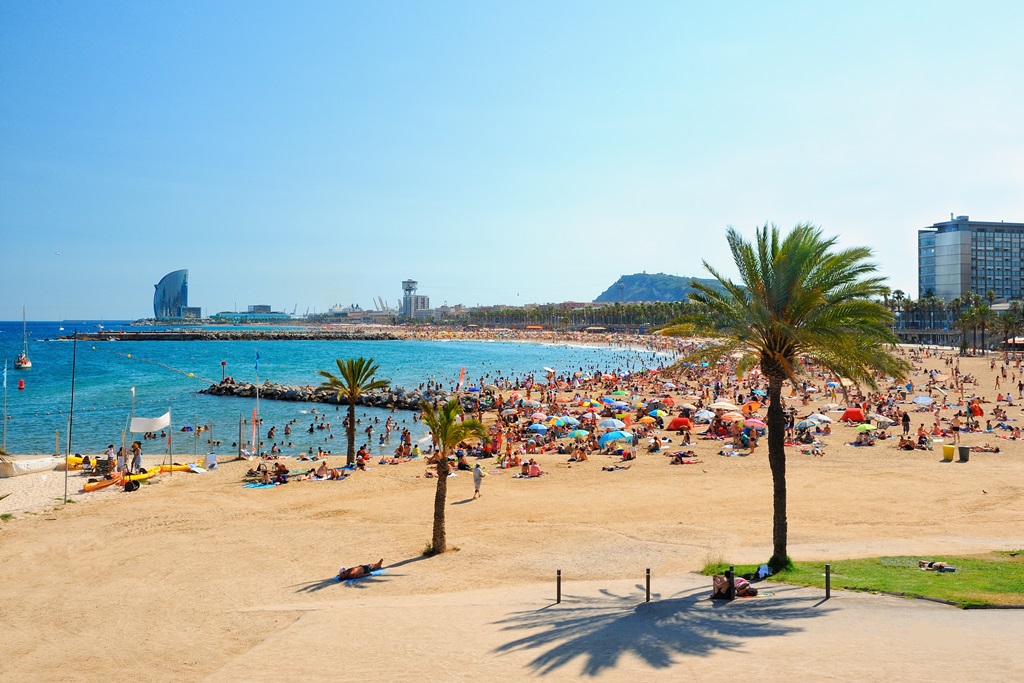Barcelona City Guide
Home of Pablo Picasso and Antoni Gaudi combines everything that is most charming about Mediterranean cities: great weather, relaxing atmosphere, beautiful beaches, delicious food, unique history and vibrant nightlife. La Sagrada Familia, Parque Güell, Barri Gòtic and Camp Nou are just some of the things that pop up on your mind when you think of Barcelona. But Catalan capital has much more to offer and with this city guide we will help you to create your own travel plan.
Table of Contents
Getting to Barcelona
Plane: Barcelona has one international airport, called Barcelona-El Prat Airport, located 17 kilometers from the city center and it will take you around 50 minutes to get there. For more information about Barcelona-El Prat Airport check out our Airpot Bus Barcelona blog.
Bus: Barcelona has two central bus stations, Barcelona-Sants Bus Terminal and Barcelona Nord Bus terminal, so make sure to check which one you need to reach.
Train: Main railway station of Barcelona is Barcelona Sants, which is located around 4 kilometers from the city center, from where you can reach various parts of Spain. For information about routes, arrivals, departures and prices check the website of Spanish rail.
Public Transport
Barcelona is served by a comprehensive local public transport network that includes a metro, a bus network, two separate modern tram networks, a separate historic tram line, and several funiculars and aerial cable cars. To see all information about the network maps, schedules, frequencies or ticket prices check Barcelona’s public transport website.
Parking Service
If you’re heading to Barcelona by car you’ll need to think about parking, which unfortunately can be a bit of a pain at times. Just like in any other large city, finding the parking spot is a challenge. You can try to find a free space on the street or you can park your car in one of 150+ multi-storey car parks. Barcelona has 3 different parking zones marked with 3 different colors.
- Green and blue zone are mostly residential zones and finding a free parking spot is hard and expensive.
- White zone marks free parking spots, it’s further away from the city center. Luckily if you want to park your car in the city center or close to most popular sights, multi-storey car parks can be found close by.
Sights
La Sagrada Família – One of Europe’s most unconventional churches, this spectacular basilica is the most famous sight in Barcelona. The UNESCO-listed Basilica de la Sagrada Familia stands in the northern part of the city, dominating its surroundings with its 18 spindly towers soaring high above all other monuments. Designed by Antoni Gaudi, construction of this unique and breathtaking church began in 1882 and 136 years later it’s not finished yet making it the largest unfinished Catholic church in the world. It’s just over 70 percent finished now and the goal is to complete it by 2026 to mark the 100th anniversary of Gaudi’s death. Current architects are following Gaudi’s design, which is based on Gothic and Byzantine styles, with 18 towers of varying heights, each dedicated to a different biblical figure.
La Catedral – Towering above the center of the Barri Gòtic district is Barcelona’s principal cathedral. The Barcelona Cathedral uses the Catalan Gothic architecture of the 14th century. The name of the church is the Cathedral of Santa Eulàlia. Construction started in 1298 and finished in 1448, while the main front was done in 1898 and the dome tower in 1913. While you’re here, make sure to dedicate plenty of time to the numerous examples of artisanship that went into completing this cathedral, from its exterior details to the many gold furnishings within, including the stately altarpiece, part of the Church of Saint Severas as well as 140 statues of saints that call the cathedral home. Also don’t forget to check out the rooftop from where you will have one of the best views in Barcelona.
Barri Gòtic – The Barri Gòtic, or Gothic Quarter, is the oldest part of Barcelona, and considering its location next to the city center, also its most liveliest. Here, you’ll find beautiful examples of Roman and Medieval-era architecture rubbing elbows with the many shops, restaurants, alfresco cafes, bars and clubs that line this neighborhood’s narrow roads and picturesque plazas. And there are so many plazas to explore like Plaça de la Catedral, which you’ll no doubt end up in if you visit the Barcelona Cathedral. Another notable plaza is Plaça Sant Jaume, where the Catalan seat of government has been since the Middle Ages. If you are looking for some less crowded spots Plaça Reial and Plaça Sant Felip Neri, which was bombed by Spanish dictator Francisco Franco during the Spanish Civil War, are for you. But if you are looking for opposite of these two plazas then you should visit Plaça Reial
Parque Güell – Colorful, cheerful, and full of whimsy, this splendid magnificent park is another work of art by Antoni Gaudí. The area was originally meant to be a residential property development with Gaudi doing much of the planning and landscape design. But only two houses were built and the land was later sold to the city of Barcelona and turned into a park. Created between 1900 and 1914, the Parque Güell is beautifully landscaped and features architectural elements in Gaudí’s signature style. Viaducts, grottoes, a colonnaded hall, winding staircases, and semi-closed conversation seats are scattered throughout the space. These creative structures are decorated in multicolored ceramic fragments. A spectacular terrace offers panoramic views of the city and the sea. Gaudí himself loved this area of the city, and his home was located here. Surrounded by a pleasant garden, the Casa Museu Gaudí occupies the house where Gaudi lived and now serves as museum where you can find various Gaudi’s work.
Monestir de Pedralbes – The Monestir de Pedralbes is a beautiful gothic monastery which was built in 1326 by Queen Elisenda in an effort to be forgiven for her sins. The nuns who lived there were mainly the daughters and widows of the nobility and wealthy local families. They were provided with protection and shelter, and in return their families left donations to the monastery. The complex features a magnificent Gothic church, a serene three-story cloister, and peaceful convent buildings. Another highlight of a visit is the Monastery Museum, which displays an outstanding collection of medieval art from the 14th century as well as later religious art created through the 20th century. Also take your time to relax in the idyllic garden, in the center of the monastery, filled with native shrubs, palms, cypresses, and shady trees
Casa Batlló – Another amazing Gaudi creation is Casa Batlló, one of the most characteristic Modernist buildings in Barcelona. The fantastical mansion was designed as a private residence for the textile manufacturer Josep Batlló i Casanovas. With its freely swinging shapes and ornamental facade, this dreamlike building looks like a castle from a surreal fairy tale. Most of the design details depart completely from any architectural precedent. The window frame on the first floor is bordered by swinging shapes that suggest plants, others resemble entrances to caves. On the facade, decorative glazed ceramic tiles in green, blue, and ochre colors add to the flamboyance.
Casa Mila – La Pedrera, which translates to “The Stone Quarry” because of buildings resemblance to open quarry, but mostly known as Casa Milà was the last civil work designed by Antoni Gaudi. Built between 1906 and 1912, this flamboyant avant-garde dwelling resembles a work of sculpture more than a functional building. Every line of the natural stone facade is curved, with rounded windows and metal balcony railings twining around in plant-like shapes. Even the roof has a wavy shape complemented by the decorative chimneys. Casa Milà also hosts a large exposition of Gaudi’s work.
Museu Picasso – While most people know Pablo Picasso for his distorted portraits, this museum displays his work on a timeline of sorts, allowing you to follow his progression from the more controlled works of his early years to the very whimsical paintings and sculptures from the end of his career. The museum also explores the artist’s lifelong relationship with Barcelona, explaining why he chose the city for his museum before he died. Museu Picasso holds several thousand pieces by him, including works from his famous Blue Period and it is for a reason most popular museum in Barcelona.
Outdoor activities
Parc de la Ciutadella – The Parc de la Ciutadella is a lot happier place today than when it was founded in 1714. After Philip V conquered Barcelona, he ordered a to be built by forced labor so he could maintain control over the Catalans. Over the centuries it transformed into peaceful uses, becoming a major oasis of green in the city. Today it is home to a zoo, a small lake, the Museum of Natural Science, and Als Voluntaris Catalans, a sculpture honoring Catalans killed in World War I. Park is perfect for long walks, picnics and also you can use a rowing boat on the lake!
Wander around Las Ramblas – When you are visiting Barcelona it is almost impossible to not visit Barcelona’s most famous boulevard. During the day, you can peruse souvenir stands, watch buskers and street performers, pick up some local art from artists selling on the street, or sit down and enjoy a light snack at one of the many alfresco cafes found here. When the sun sets, you should head here to start your night out, as many bars and clubs can be found in the surrounding area.
Watch the sunset from Bunker del Carmel – Built during Spanish Civil War in 1937, bunkers were used as part of anti-craft defense. After the war, the guns were removed and the bunkers were simply left to crumble. Yet the view from the site was too lovely to stay neglected for long and eventually the old bunkers became known as one of the best views in whole Barcelona.
Climbing at Montjuïc – Montjuïc is the setting for the largest “rocòdrom” in Europe. On the part of the hill known as La Foixarda, Climbat is a newly opened climbing center, with 800m² of scalable surfaces, a cafe and specialist bookshop. Both beginners and advanced climbers can take courses and hire equipment. Near the centre there are two 50 meter climbing walls and a disused tunnel studded with colour-coded holds, free for the public to use.
Catch a game at Camp Nou stadium – More than a club is FC Barcelona’s motto and for a right reason. FC Barcelona is a pride of whole Catalonia, and if you are visiting Barcelona during La Liga season catching a game at Camp Nou is a must. Being in the crowd of nearly 100 000 screaming fans and watching some of the most famous football players on the pitch is a lifetime experience. But if you come in football offseason, when no games are played then check out on site museum which showcases trophies and awards the team has garnered through the years.
Beaches
Barceloneta Beach – Located on the coast of the popular neighborhood which shares its name, La Barceloneta beach is Barcelona’s most bustling and touristy stretch of sand and sea. This inevitably makes it one of the most crowded beaches in Barcelona, but it compensates for this with its surplus of entertainment and variety of water sports.
Nova Icaria Beach – Nova Icaria beach is considered the most peaceful in Barcelona, and thus a perfect choice for families or those looking to relax.
Ocata Beach – North of Barcelona, Ocata is quiet, pristine and very flat, with oodles of space on the beautiful golden white sand. It’s a half-hour trip on the train out of the city.
Mar Bella – Much more peaceful then La Barceloneta or Sant Sebastia is perfect location to relax in the clean and calm surrounding. Mar bella is also a great location to try out water sports like windsurfing, kayaking etc.
Sant Sebastia – This beach is the closest to the eastern end of Barcelona and stretches for over a kilometer, making it one of the longest beaches in Barcelona. Attracting not only tourists, but also many regulars from Barcelona itself, Sant Sebastia beach, much like La Barceloneta, boasts a busy and lively atmosphere throughout the year.
Nightlife
The delightful mix of urban glamour and laid-back charm is well reflected in the city’s staggering night scene, where sidewalk cafes and casual bars stand along trendy discotheques and clubs. Unsurprisingly, Barcelona offers something for every partygoer, from rock and jazz to classical and electronic. The Moog is hailed as the first place to have introduced techno to Barcelona and still puts on some of the best techno nights in the city. Open every night of the week and located just off La Rambla, it attracts a mix of locals and travelers. The clubbing mecca which is Razzmatazz also has a room dedicated to electro, house and techno, called The Loft, as well as a somewhat gentler dance-floor called Lolita with electronica, disco and house. The Port Olimpic is home to a number of nightclubs like Pacha, Barcelona’s own branch of the iconic Ibiza club, also Opium is located there which is nightclub by night and restaurant during the daytime. Sala Apolo was once a theatre but now serves as a nightclub, the venue has kept its theatrical appearance and attracts locals and tourists. More exclusive and glamorous nightclubs are CDLC club and Catwalk Club, which host world famous DJs on regular basis. If you are more into alternative music like indie, rock and punk then Manchester Bar, Polaroid Bar or the Sidecar Factory Club are your destination.
Shopping
Barcelona’s most elegant, fashionable and international shopping street is called Passeig de Gracia. Passeig de Gracia is perhaps the most expensive but also the nicest street in Barcelona for shopping and where you can find many top designer brands and some of the flagship stores of the top Spanish and International luxury brands. For a large selection of top high street brands continue over Plaza Catalunya and onto the pedestrian street Portal de L’Àngel. Here you can find H&M, Zara, Mango, Bershka etc. Rambla de Catalunya is one of Barcelona’s most charming streets for strolling and there are many cute small boutiques and shops in a mix of styles. There are many are small fashion boutiques, accessory shops and gift shops. For small intimate fashion and artisan boutiques head to the Barri Gòtic where you can find many small interesting shops. If you are looking for malls or outlets where you can find multiple desired shops for your price range, head down to Gran Via 2, Diagonal Mar Center Commercial, Pedralbes Center, El Triangle, Maremagnum, Las Arenas or Les Glories.
Exchange Money
As in most European countries, including Spain, Euro (€) is official currency. You can exchange your money in banks or currency exchange offices but it can be quite expensive. So the most convenient option is to bring some euros with you or withdraw money from ATMs, which you can find all around the city.
Useful contacts
Emergency
Common EU emergency number: +34 112
Emergency ambulance: +34 061
Hospital
Hospital General de la Vall d’Hebron: +34 932 746 100
Hospital Clínic i Provincial: +34 932 275 400
Hospital de la Santa Creu i Sant Pau: +34 932 919 000
Hospital del Mar: +34 932 483 000
Hospital Sant Joan de Deu: +34 932 532 100
Tourist helpline and emergency number: +34 902 102 112 (in English, French, German and Italian)
Police
Local police: +34 092
National Spanish police: +34 091
Catalonian police: +34 088
Tourist Information Center
Aeroport del Prat, Terminal 1 and Terminal 2
Oficina Catedral, Plaça Nova, 5
Plaça de Catalunya, Plaça de Catalunya 17-S
Plaça Sant Jaume, Ciutat, 2 (Ajuntament de Barcelona)
Estació de Sants, Plaça dels Països Catalans, s/n
Mirador de Colom, Plaça del Portal de la Pau, s/n
Cabines d’informació turística, various locations at strategic points around Barcelona















